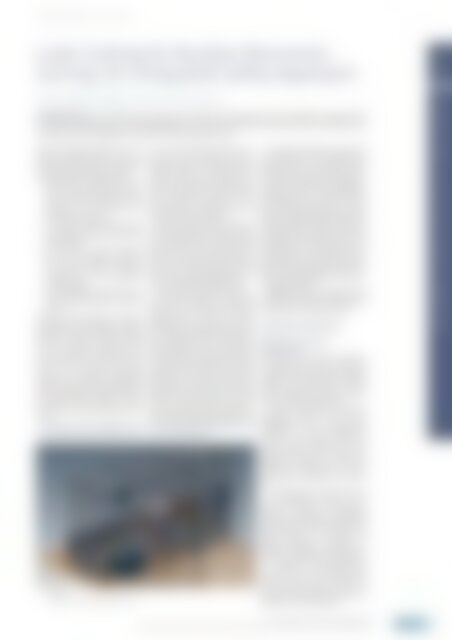atw 2018-10
You also want an ePaper? Increase the reach of your titles
YUMPU automatically turns print PDFs into web optimized ePapers that Google loves.
<strong>atw</strong> Vol. 63 (<strong>2018</strong>) | Issue <strong>10</strong> ı October<br />
Laser Cutting for Nuclear Decommissioning:<br />
An Integrated Safety Approach<br />
Howard Chapman, Stephen Lawton and Joshua Fitzpatrick<br />
Introduction Laser cutting has been proposed as a method of size-reduction of active materials for operations such<br />
as nuclear decommissioning. Laser cutting combined with semi-automated control is faster and far more efficient than<br />
conventional cutting techniques and will produce less secondary waste.<br />
The key potential benefits over traditional<br />
cutting methods in terms of<br />
reducing the risk to As Low As Reasonably<br />
Practicable (ALARP) include:<br />
• Narrower kerf widths than traditional<br />
hot cutting methods, resulting<br />
in reduced dross and fumes,<br />
leading to less radioactive contamination<br />
and waste.<br />
• No vibration transferred into the<br />
waste piece which could mobilise<br />
contamination.<br />
• Less thermal energy imparted<br />
into the cut materials than other<br />
hot cutting methods, therefore<br />
reducing the risk of volatilising<br />
contamination.<br />
• No consumables required for laser<br />
cutting, which generate secondary<br />
waste.<br />
The use of laser cutting is a mature<br />
technology in widespread use in other<br />
industries and the modular design<br />
offers the capability of being scaled<br />
to meet nuclear requirements and<br />
remote deployment. During cutting,<br />
there are no reaction forces and<br />
cutting can be achieved on difficult<br />
shapes. The cutting tool is lightweight<br />
and the equipment has good tolerance<br />
to stand-off control which is a great<br />
benefit for remote operations in active<br />
areas.<br />
The NNL robot controlled laser<br />
cutting demonstration facility is a first<br />
| | Fig. 1.<br />
NNL Robot Controlled Laser Cutting Facility.<br />
of a kind full-scale replica of an<br />
existing active handling enclosure<br />
operated by NNL. The replica demonstration<br />
facility has recently been<br />
constructed at the NNL Preston Laboratory<br />
and is claimed to be the world’s<br />
most advanced per manent robot<br />
controlled laser cutting system in an<br />
active nuclear environment.<br />
Major world first achievements by<br />
NNL’s demonstration facility include<br />
the integration of an air-cooled laser<br />
head in an active environment; point<br />
cloud data acquisition on an industrial<br />
robot and a semi-automated system<br />
that provides path planning and executes<br />
a cut without teleoperations.<br />
NNL’s Robot Controlled Laser Cutting<br />
Facility employs an industrial<br />
robot arm with a 5kW infra-red laser<br />
equipped with a series of two fibre<br />
optic cables connected in series, and an<br />
air-cooled laser cutting head. The facility<br />
is equipped with a Local Exhaust<br />
Ventilation (LEV) system and has been<br />
used to perform a variety of novel trials<br />
to provide unique information on fume<br />
generation. The results of the active<br />
experiments on fume generation from<br />
NNL’s Robot Controlled Laser Cutting<br />
Facility, will allow aleatory and epistemic<br />
uncertainties when using lasers<br />
within decommissioning environments<br />
to be refined and disseminated to the<br />
wider nuclear industry.<br />
This paper provides an overview of<br />
the production of an integrated fit for<br />
purpose safety case for NNL’s Robot<br />
Controlled Laser Cutting Facility starting<br />
with consideration of regulatory<br />
requirements from a United Kingdom<br />
(UK) perspective. The safety case for<br />
the facility is based upon on a robust<br />
defence in depth Hazard Management<br />
Strategy (HMS) which has been used<br />
to identify safety measures which are<br />
proportionate to hazard severity. The<br />
development of an integrated safety<br />
case approach for the facility has enabled<br />
the often competing needs of different<br />
hazard disciplines to be harmonised<br />
and managed.<br />
Figure 1 shows a Computer Aided<br />
Design (CAD) model of NNL’s Robot<br />
Controlled Laser Cutting Facility.<br />
Assessment of hazards<br />
Regulation and legal<br />
requirements<br />
The civil nuclear industry worldwide<br />
is regulated to ensure that activities<br />
related to nuclear energy and ionising<br />
radiation are conducted in a manner<br />
which adequately protects people,<br />
property and the environment.<br />
In the UK, the Office for Nuclear<br />
Regulation (ONR) is the agency<br />
responsible for the licensing and<br />
regulation of nuclear installations<br />
and the legal framework for the<br />
nuclear industry is based around the<br />
Health and Safety at Work Act<br />
( HSWA) [1], the Energy Act, [2] and<br />
the Nuclear Installations Act (NIA),<br />
[3].<br />
A fundamental requirement cited<br />
in UK legislation is that risks be<br />
reduced to ALARP. This principle<br />
provides a requirement to implement<br />
proportionate measures to reduce risk<br />
where doing so is reasonable. The<br />
ALARP principle is applied by<br />
adhering to established good practice,<br />
or in cases where this is unavailable,<br />
it is applied to demonstrate that<br />
measures have been implemented<br />
up to the point where the cost of<br />
additional risk reduction is disproportionate<br />
to the benefit gained.<br />
521<br />
DECOMMISSIONING AND WASTE MANAGEMENT<br />
Decommissioning and Waste Management<br />
Laser Cutting for Nuclear Decommissioning: An Integrated Safety Approach ı Howard Chapman, Stephen Lawton and Joshua Fitzpatrick

















